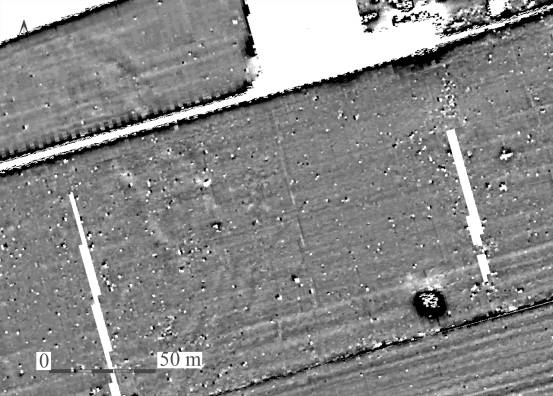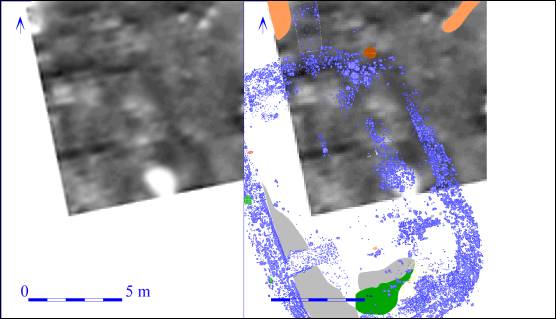
Dedicated to research into the Landscape Archaeology of Eastern Yorkshire
|
Dedicated to research into the Landscape Archaeology of Eastern Yorkshire
|
|
|
How does magnetometry work?A magnetometer can detect two types of magnetism; permanent or remnant magnetism (also termed thermoremanence), and temporary magnetism. Temporary magnetisation occurs only when a magnetically susceptible material is placed in an external magnetic field. The material will then acquire a magnetic field of its own in addition to that of the outside field, but will lose this field if the external field is taken away. This occurs because of the material's magnetic susceptibility, which is the ease with which a magnetic field can pass through a material, so that the higher the material’s magnetic susceptibility is, the stronger its induced magnetic field will be (Clark, 1996, 65-66 and 99-100). For the purposes of archaeological magnetometry the external field is provided by the Earth’s magnetic core, and is thus never “off”, so that magnetic techniques of archaeological prospection are not weather dependent, and can be conducted at any time. Initially, magnetometers were used to detect the presence of kilns or furnaces, which are permanently magnetised. They acquired their thermoremanence by being fired above a temperature known as the Curie point, which varies depending on the minerals present in the material. For example, haematite will pass this point at 675 C, while for magnetite it is lower, at 565 C (Clark, 1996, 65: Gaffney and Gator, 2003, 37). What happens is that the iron content of the various clays present in the construction of the kiln are effectively de-magnetised at the Curie point. As the kiln subsequently cools, the iron in the material is re-magnetised with a new permanent magnetic alignment, based on the current orientation of the Earth’s magnetic field. Iron is the other major source of permanent magnetism detected in magnetometer surveys, and it produces a very strong localised signal. These peaks, or dipoles (see below), are normally displayed as small black and white peaks (in greyscale images) or very localised positive-negative signals (in trace plots) in processed survey data. Although they can pinpoint the location of buried archaeological artefacts, in practice this is a rare occurrence, and they generally tend to indicate the presence of relatively recent iron objects (i.e. horse shoes, cans, shotgun cartridges, broken ploughshares, etc). 
However, even in the initial proton magnetometer surveys by Aitken (Aitken, 1958, 24-26), it was realised that the magnetometers were also detecting much more subtle magnetic anomalies, which equated with the infill of buried ditches and pits. The detection of this “settlement” evidence has become the most prevalent use of magnetometry in archaeological geophysics today. The reason for this is that many forms human activity tend to increase the magnetic susceptibility of soils, and this enhanced material then forms part of the fills of cut features (for example pits and ditches) present at the time of the magnetic enhancement. This human enhancement of susceptibility is primarily heat derived, through cooking, kilns, furnaces, pottery making and other activities. Contrast in susceptibility is fundamental in the detection of these subtle archaeological features. If the contrast between the surrounding subsoil and the infilled features is not substantially different, then it is unlikely that magnetic techniques will identify these features. Also, if the overlying topsoil or ploughsoil has a substantially higher magnetic susceptibility than the contrast between the underlying infilled features and the subsoil, then the technique will only be of limited value in archaeological feature detection. Although magnetometers are not generally used for this purpose, it is also possible to detect buried walls, which generally show up as “negative” anomalies, that is they are less magnetically susceptible than the surrounding subsoil. 
This can be seen in Figure 162 , where the initial magnetometer survey on the left is compared with the excavated features superimposed on the right, with blue indicating the location of a robbed out chalk wall, with only the lowest foundations remaining. While it can be seen that there is a direct correlation between the location of the wall foundation and a negative (darker) magnetic anomaly, it is also clear that a number of negative anomalies present in the magnetic survey clearly do not relate to buried wall features, and it for this reason that magnetic surveys are not generally used for the detection of buried masonry. However, large scale buildings such as Roman villas and towns (Buteux et al, 2000, 69-80, although the entire volume is devoted to Wroxeter), as well as Medieval monasteries and abbeys (Gaffney & Gator, 2003, 164) seem to respond well to magnetic techniques.
Back to Main Magnetometry Index
|
Copyright © 2006 The Landscape Research Centre Ltd. Registered Charity No. 326710 All rights reserved.
|